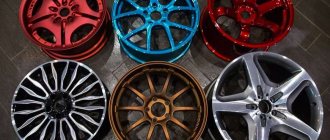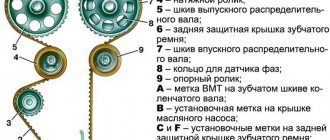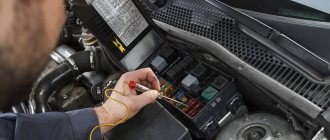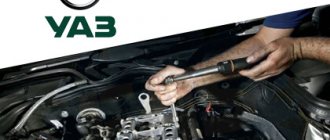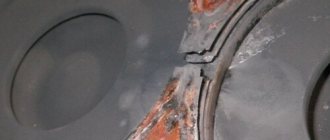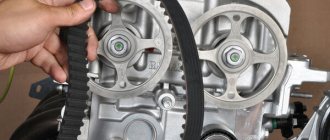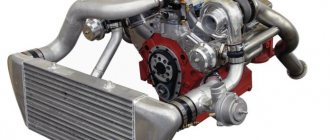Replacing the Chevrolet Aveo timing belt: articles, photos, videos
Many Chevrolet Aveo owners were faced with the need to replace the timing belt. In a car service, this operation is quite expensive. We will try to figure out how to carry out the procedure with our own hands, and also consider which chains are suitable in addition to the original part.
Video material
The video will tell and clearly show the process of replacing the timing mechanism on a Chevrolet Aveo.
Replacement procedure
Before proceeding directly to the replacement process, you need to understand that this procedure is quite complicated and will require considerable time. Thus, it is recommended to study the technological diagrams, as well as the design features of the motor. Next, we will collect the necessary tools to carry out the replacement.
Belt and two rollers.
Let's consider the sequence in which operations should be carried out to change the timing belt on a Chevrolet Aveo:
Remove the side timing belt protective cover.
We set the timing marks.
We match the marks with the crankshaft pulley.
We dismantle the belt and two tension rollers.
We install new tension rollers.
Installing a new belt.
The process of replacing the Chevrolet Aveo timing belt may seem difficult, and therefore it is worth calculating your strength. If the car owner is not sure, it is recommended to contact a car service center for operations. On average, the shift process can take from 1 hour to 3 hours.
Pump key
To turn the pump you need a 41 mm wrench. You can purchase a special key. He looks like this
Or cut a regular open-end wrench to 41
And weld a head or something similar to it.
But personally, I am for the first option. The cost of a key ranges from 70 to 200 UAH, depending on the manufacturer and the thickness of the metal.
They are very comfortable to work with
In general, turn the pump counterclockwise and remove the belt
Pay attention to the photo above. Only the left side of the belt is loosened, while the right side remains taut. This point will be useful to us when installing a new belt.
Unscrew the bolts of the camshaft pulleys. If you forgot to remove them in advance while the belt was still installed, then you need to fix the pulleys.
Important! Do not use nuts or bolts placed between pulleys for fixation. This will inevitably leave marks on the working surfaces of the pulleys. This damage will then destroy the belt, possibly causing it to break!
Important! It is not allowed to rotate the camshafts with the timing belt removed!
To hold the pulley, you can use special devices. I use shock absorber strut spring clamps.
Note. The pulleys are different. The left is different from the right. The left one simply does the job of turning the camshaft. And the right one still works with the camshaft position sensor. And there is a special ebb on it that acts as a mark for the sensor.
It is impossible to confuse the position of the pulley on the camshaft, since there is a hole on the pulley
And there is a special pin on the camshaft
Unscrew the two bolts securing the DPRV with a 10 mm socket and remove it
Use a 14 or 15 mm socket to unscrew the deflection roller
Using a 12 mm socket, unscrew the three bolts securing the tension roller and remove it
We unscrew the rear timing case mounting bolts in these places
And dismantle the casing
We unscrew the pump mounting bolts and dismantle it
To dismantle the crankshaft pulley, simply unscrew the crankshaft bolt and remove the pulley
We inspect the pulley and, if there is the slightest defect, replace it with a new one.
We clean the pump seat very carefully. And we treat it with fine sandpaper so that there are no sagging or traces of corrosion.
Note. If you do not prepare this area perfectly, then the pump may become slightly misaligned. And this will lead to the fact that the belt may begin to slip off the pulleys while the engine is running!
Part selection
Almost all Chevrolet cars, including those made in Korea, are equipped with General Motors spare parts. At the same time, Aveo was no exception. The original timing belt for the Chevrolet Aveo has a catalog number of 24,422,964. The average cost in the automotive markets is about 4,000 rubles.
Also, it is worth considering that you will have to take two tension rollers. You can purchase everything in one set, but it is better to select them separately. Timing belt tension roller - 55,574,864, cost - 8,000 rubles. Timing belt guide roller - 24 436 052, with a price tag - 2000 rubles. The total cost of replacement parts for the original is 14,000 rubles.
Timing belt replacement kit.
Analogs
You can choose analogues for those who want to save money without losing quality.
Source
Engine Chevrolet F14D4
The F14D4 engine has been produced by GM DAT since 2008. This is an inline 4-cylinder power unit with a cast iron cylinder block. The 1.4-liter engine develops 101 hp. With. at 6400 rpm. It is called the original Chevrolet Aveo engine.
Description
This is a modernized F14D3, but a system for changing the gas distribution phases on both shafts has been added, individual ignition coils have been installed, and an electronic throttle is used. The service life of the timing belt has noticeably increased, which on its predecessor would break very quickly, which led to a major overhaul. If previously it was necessary to monitor the belt and rollers every 50 thousand km, then on the new F14D4 this can be done once every 100 or even 150 thousand km.
The designers removed the EGR system. Indeed, it was a lot of trouble, not good. It was precisely thanks to the elimination of this valve that it was possible to increase the engine power to 101 horses. This figure is a record for a small-displacement engine!
Flaws
As for the minuses, there are quite a few of them left over from its predecessor. Certain problems are associated with the system for changing GDS modes, although it is considered as an innovation and advantage. The fact is that the solenoid valves of the phase regulator quickly deteriorate. The car starts to run noisily, like a diesel engine. Repair in this case involves cleaning the valves or replacing them.
There are no hydraulic compensators on the F14D4, and it is now possible to adjust the gaps by selecting calibrated glasses. On the one hand, no one has canceled the advantages of the automated process, but in reality the predecessor F14D3 (with hydraulic compensators) had many more problems. As a rule, the need to adjust the valves arises after the 100,000th mileage.
Another weak point of the new engine is the thermostat. The GM concern is in first place among other manufacturers in this matter. He can’t make thermostats properly, they don’t hold up, that’s all! After 60-70 thousand kilometers, the part must be checked and replaced if necessary.
| Production | GM DAT |
| Engine make | F14D4 |
| Years of manufacture | 2008 – our time |
| Cylinder block material | cast iron |
| Supply system | injector |
| Type | in-line |
| Number of cylinders | 4 |
| Number of valves | 4 |
| Piston stroke | 73.4 mm |
| Cylinder diameter | 77.9 mm |
| Compression ratio | 10.5 |
| Engine capacity | 1399 cm3 |
| Engine power | 101 hp /6400 rpm |
| Torque | 131Nm/4200 rpm |
| Fuel | gasoline 92 (better 95) |
| Environmental standards | Euro 4 |
| Fuel consumption | city 7.9 l. | track 4.7 l. | mixed 5.9 l/100 km |
| Oil consumption | up to 0.6 l/1000 km |
| What kind of oil to pour into F14D4 | 10W-30 or 5W-30 (Low temperature areas) |
| How much oil is in the Aveo 1.4 engine | 4.5 liters |
| When replacing, pour | about 4-4.5 l. |
| Oil change is carried out | once every 15,000 km |
| Resource Chevrolet Aveo 1.4 | in practice – 200-250 thousand km |
| What engines was it installed on? | Chevrolet Aveo, ZAZ Chance |
3 ways to upgrade
This engine does not have the same tuning potential as the F14D3 due to its small volume and other reasons. Using conventional methods, increase performance by more than 10-20 hp. s., it’s unlikely to work. The fact is that it is not possible to install sports camshafts here; they are not even on sale.
As for possible methods of alteration, there are three of them.
Air filter for F14D4 engine
Any of the described methods of modifying the engine's life will not extend it. On the contrary, installing a compressor will significantly shorten its life. True, there is a way to improve the situation somewhat by installing forged pistons with grooves. But this is expensive, and is used only for building a turbo version.
Eventually
The F14D4 engine has many advantages. This includes an improved timing belt that lasts a long time, a high-quality pump, and the absence of an EGR valve. The crankcase ventilation is well thought out, allowing gases to escape from the throttle area. Therefore, the damper rarely becomes dirty, which is a big advantage for an electronic drive. It is also easy to replace the oil filter on this engine - this is done from above, without a hole.
The procedure for replacing the timing belt on a Chevrolet Aveo 1.4 liter 16 valves with photos and videos
An old, battered Chevrolet Aveo, under the hood DOHC 1.4 liter, timing belt replacement at 120,000 kilometers. The E-TEC II engine bends all valves when the belt breaks. Since the car is manufactured by General Motors, the replacement procedure will be very similar to the Nexia. The only problem with replacement is that the belt is tensioned by the pump.
In order to change the timing belt on this car we will need: a great desire, two cups of coffee and a special key for 41. If there are no problems with the first two, then a special key must either be ordered in advance (for example, here, price 700 rubles) or made yourself. We used to make it out of metal about 2 mm thick, it didn’t turn out very nicely, but as they say, “no fish, no fish.” Materials: timing belt, tensioner and idler pulley, and always a pump. We definitely change the pump . Because as soon as you turn the old pump, when you re-tension it, it will definitely leak.
We begin work with an external inspection.
Let's get started
First, remove the air filter cover and all interfering pipes.
As well as the air filter housing.
We remove the front right wheel, engine protection, drain the antifreeze and jack up the engine. We unscrew the right mudguard, a 10mm socket will help us, and remove it.
Remove the right engine mount. To do this, unscrew the four bolts and two nuts to 17.
We remove the cushion and see the attachment belt and tension roller.
3 – air conditioning compressor clutch.
Using a 14mm wrench, turn the tension roller bolt clockwise until the service belt loosens and remove the latter.
Remove the upper protective timing cover; to do this, unscrew two 10mm bolts.
Set the top dead center. We turn the crankshaft by the pulley mounting bolt clockwise until the two marks on the camshaft sprockets coincide.
Remove the crankshaft pulley. To remove the bolt, we will need to either lock the crankshaft in any way, or use some trick. Let's consider the second option. We engage fifth gear, place stands under the rear wheel and insert a suitable screwdriver into the brake disc so that it jams the disc against the caliper. Unfortunately, we didn’t take a photo, the picture shows the installation location, the only thing that needs to be installed is below the caliper, because it will spin counterclockwise.
The mark on the crankshaft should also match.
We put additional tags, you can do without them, but additional control will never be superfluous. “It’s better to be safe than sorry!” - folk wisdom.
We remove the lower protective timing cover and again the ten-point head will help us. There is a latch at the bottom left.
A wonderful picture appears before us.
1 – intake camshaft sprocket.
2 – exhaust camshaft sprocket.
4 – bypass (parasitic) roller.
5 – pump (water pump).
6 – crankshaft sprocket.
Loosen the pump mount, a 5mm hex wrench will come in handy here.
We substitute a basin, because even though we drained the antifreeze, there is still a lot of it left in the block.
Remove the engine mount bracket.
Turn the pump counterclockwise with a 41 key until the timing belt loosens. We remove the parasitic roller.
Remove the old timing belt.
We unscrew the camshaft sprockets with a 17 key, having previously locked them.
Remove the camshaft sprockets.
Remove the tension roller and plastic protection. The photo doesn't show the top two bolts, but you can easily find them.
We remove the old pump and install a new one, as shown in the photo. Do not tighten the fastening bolts.
We put the plastic, rollers, camshaft sprockets in place, and tighten all the bolts.
We install the new timing belt in the direction indicated on it. First we check all the marks; the intake camshaft will slide down a little. We put on the timing belt in the following sequence: first on the crankshaft sprocket, idler pulley, exhaust camshaft sprocket, intake valves, tension roller and pump. We check that the descending branch of the belt is always tensioned,
We tighten the belt. Using a special 41 key, turn the pump clockwise until the marks on the tension roller match. Tighten the water pump mounting bolts.
We check all the marks.
We turn the crankshaft two turns and check the marks again. If everything matches and the pistons and valves do not meet, we assemble them. We put everything that was removed in the reverse order of removal, tighten all the bolts and nuts. Fill with antifreeze. Now you can change the timing belt on a Chevrolet Aveo without much effort.
Chevrolet Aveo belt replacement
Good luck on the roads. Not a nail. Not a rod!
How to install the timing belt correctly
Now the most important thing and what we have been going to for so long. Installing the belt.
First of all, wash your hands thoroughly.
We take a new belt and carefully inspect it so that there are no creases, protruding threads, etc. The belt may have been damaged during packaging, transportation, etc.
If the belt has marks on the direction of rotation, then install it that way
That is, the engine rotates clockwise, so we install the belt this way (arrows to the right)
The belt is put on starting from the crankshaft and counterclockwise. Don't put it on the camshafts right away. It is not right.
In general, we put it on the crankshaft pulley and tighten the right side of the belt as much as possible (remember how it was when we removed the belt?)
To do this, turn the exhaust (right) pulley a little clockwise and put a belt on it
Then return the pulley to its place (turn it counterclockwise). This will give maximum tension on the right side. After all, the tensioning device is installed only on the left shoulder of the belt, so the right shoulder must be pulled by hand and the entire remainder of the belt must be pulled to the left. I hope it's clear. But, and if not quite, then on video you can watch this process live, so to speak.
Our left pulley constantly tends to the right. Therefore, using a 17 mm wrench, we need to turn it ALMOST until the marks coincide and hold it until we put the belt on it
I’ll show you why ALMOST now.
In general, we put the belt behind the tension roller and the pump. He stands still. The right side is taut, but the left side is still loose.
Our tags look like this. As you can see, the left label looks a little down
And when we tighten the belt, then the pulley will turn a little and the marks will coincide clearly!
Rotate the pump clockwise, tensioning the belt until the marks on the tensioner match. In this case, the marks on the pulleys also match
Replacing the timing belt for Chevrolet Aveo 1.4 16v generation T250
To ensure long and uninterrupted operation of the car, it is necessary to carry out diagnostic procedures from time to time and replace worn parts in a timely manner. One of the regulated procedures on the Chevrolet Aveo 1.4 is replacing the timing belt. Here you can study the most detailed instructions on how you can do this yourself without involving specialists.
The timing belt is a sort of flexible rubber hoop reinforced with a metal frame. It connects the camshaft and crankshaft, thus ensuring the operation of the pistons and valves. The belt prevents the pistons and valves from meeting, so it is very important. But if it breaks, the meeting of these parts becomes inevitable, and this will certainly lead to bending of the valves, and this is a very serious malfunction. To prevent this from happening, it is necessary to carry out diagnostic procedures and change parts in a timely manner. The belt must be replaced if the following defects are found:
Recommendations for timing and materials
It is better to replace the pump and tension roller along with the belt. Of course, you can leave them if there are no obvious signs of wear or damage on the surface. If oil leaks are found on the belt, then the reason for the oil leaks lies in the seals. This means that they also need to be replaced. If this is not done, oil will continue to drip onto the new belt, which will very soon lead to corrosion.
Installing new pulleys and timing belt kit.
New timing belt and pulleys.
We install a new timing belt and fasten the rollers. We tighten the belt and set the installation marks. This must be done with high precision. Check the belt tension. We pull out the bar and turn it manually to check the marks. The marks are set. We install the timing belt cover and a new drive belt. We degrease the seat in the valve cover for the gasket and install a new gasket. Screw on the valve cover. Tighten in a certain order. Let's start it up. The engine runs smoothly. "CHECK" was extinguished.
Timing belt. Purpose.
The timing belt is designed to provide a flexible and silent connection between the camshaft and the crankshaft, as well as the synchronization of the opening and closing of the valves with the operation of the pistons. If the belt breaks or jumps off, the open valve is damaged by the impact of the piston. As a result, large financial expenses for engine repairs.
When to replace the timing belt
Belt breakage always happens when you don't expect it. To prevent this situation from occurring, it is necessary to check its condition at regular intervals and, if necessary, change it.
Planned replacement is carried out in accordance with the terms specified in the vehicle’s operating manual and in the service book. As a rule, its service life depends on the car model and engine type. For HYUNDAI, KIA and CHEVROLET cars it must be changed every 60 thousand kilometers. There are cars in which replacement occurs after a mileage of 90 thousand kilometers. This mainly applies to MITSUBISHI cars. In cases where the timing of replacing the timing belt is unknown or there is doubt about its proper condition, it is necessary to carefully visually inspect it. If there are microcracks or abrasions on the surface, urgent replacement is necessary. Also check the timing rollers, regardless of whether they have play or roll. They may also need to be replaced.
The material used for the manufacture of timing belts is rubber and metal, and this, of course, limits their service life. They cannot be repaired, they can only be replaced. Replacement must also be done when there are no obvious signs of damage. For example, if it is weakened or worn out, the synchronous operation of the pistons and valves is ultimately disrupted, which leads to unstable engine operation and difficulty starting it, especially at low temperatures.
If such a problem occurs, the water pump (pump) also requires replacement. It makes itself felt by antifreeze leaks and a decrease in its level in the cooling system. During the repair process, additional faults may also be revealed. For example, a leak was detected in the camshaft or crankshaft seals. They should definitely be changed, since then to replace them you will have to remove the belt again. And this is actually double work. The cost of repairs will be higher, but leakage problems will be eliminated in the future. The regulations establish that the timing belt must be replaced upon reaching a certain mileage or after a certain time has passed. Namely, after 4 years of operation, if replacement is recommended at 60 thousand km or after 6 years, if replacement is recommended at 90 thousand km. There are owners who do not achieve such mileage during this time. In this connection, the question arises, is it necessary to change it if the mileage is less than the established one, but the deadline has arrived? The manufacturer has clearly given a recommendation in this regard. This is shown in the service book. It must be replaced upon reaching either a certain mileage or after a certain time has passed. Whichever comes first. Therefore, even if you have not reached this mileage, we recommend replacing it. It would seem that the machine is not in use, which means that the parts do not wear out. Why change then? This is a misconception. There is such a thing as natural aging of parts. That is, even if the machine is not in use, all parts are subject to aging. And rubber spare parts are even more important than body and suspension parts. Experience shows that if a car sits for a long time and then begins to be used, many rubber parts begin to leak. Simply put, the rubber parts have become stiff. The timing belt is also subject to aging over time. Of course, it won’t break right away, but you shouldn’t delay replacing it as soon as possible.
Which timing belt should I buy?
Many owners are wondering about choosing a timing belt kit, original or non-original? Because everyone is wondering how much does it cost? The price difference can be significant. Of course, the original kit is preferable, since original spare parts undergo more thorough quality control. But among the non-original ones there are time-tested companies that produce spare parts to replace it of quite acceptable quality. Many manufacturing companies are suppliers to the assembly line, so the quality of such spare parts is quite high. If you choose non-original parts, it is best to give preference to such manufacturers. Some manufacturers produce a ready-made timing belt kit. This is very convenient for the buyer, there is no need to look for spare parts separately, the kit contains everything you need. There are even original kits for CHEVROLET Lacetti and Aveo cars. When choosing spare parts, we advise you to focus on trusted manufacturers with proven quality.
